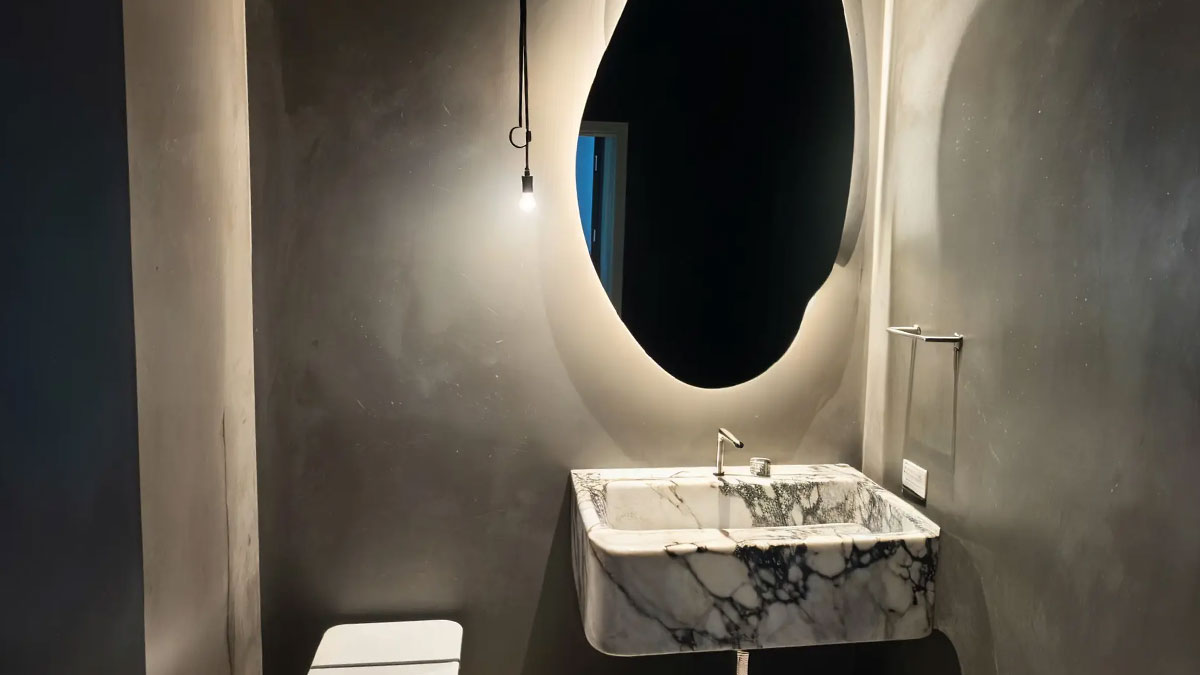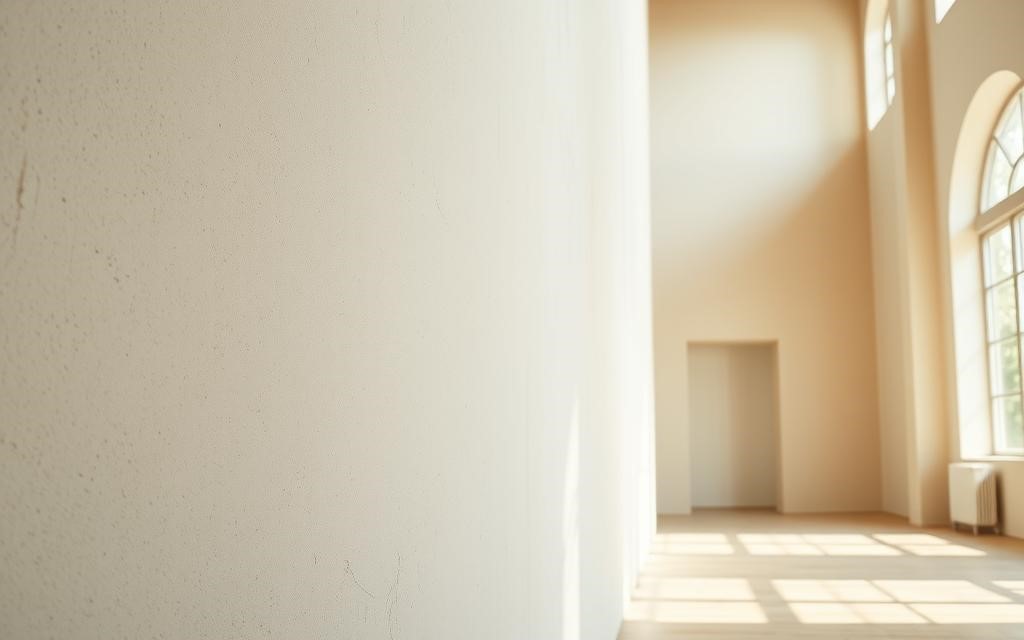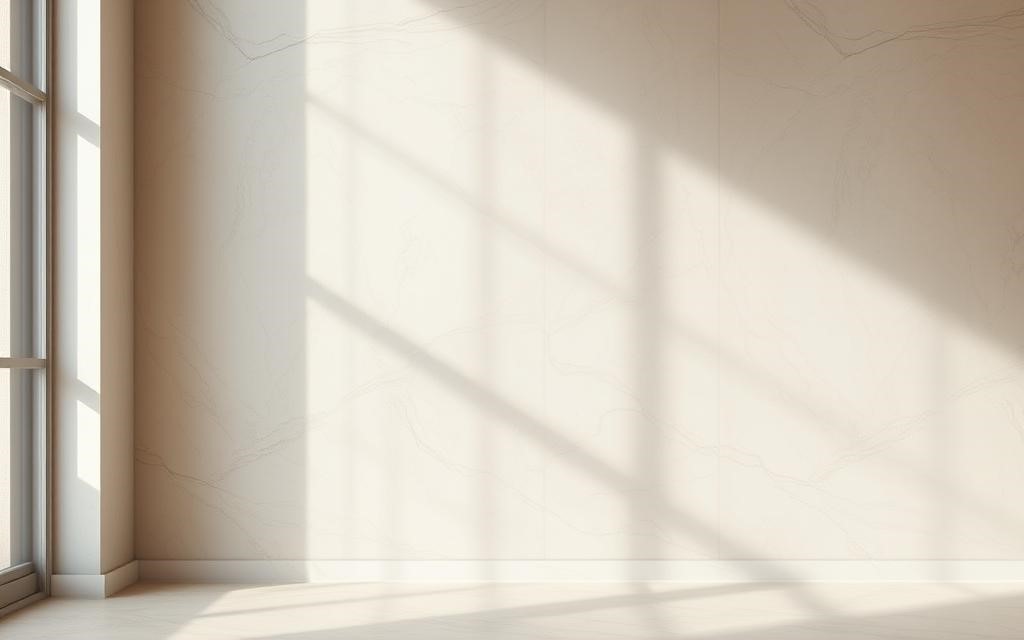Ever walked into a room and felt like you’ve traveled back in time? The magic might be in the walls. Lime-based finishes add a timeless charm that paint can’t match.
Venetian plaster and lime wash are back in style in interior design. They turn simple walls into textured works of art. These finishes capture light and create depth, telling stories through their patterns.
These finishes are more than just pretty. They’re eco-friendly and made from natural materials. They’re better for the planet and improve air quality by resisting mold.
Venetian plaster and lime wash come from the same roots but look very different. Venetian plaster gives a smooth, marble-like look. Lime wash, on the other hand, offers a soft, matte finish with unique color shifts.
These finishes are perfect for both modern homes and historic restorations. They mix old-world charm with today’s tastes. They work well with many styles, from rustic to modern.
Key Takeaways
- Venetian plaster and lime wash are traditional, eco-friendly wall finishes experiencing renewed popularity
- Both finishes are derived from limestone but create distinctly different aesthetic effects
- These natural materials improve indoor air quality and naturally resist mold growth
- Lime-based finishes add depth, texture, and character that conventional paint cannot achieve
- These versatile treatments complement various design styles from historic to contemporary
- Both options transform ordinary walls into extraordinary architectural features
Table of Contents
The Beauty and Benefits of Natural Lime Finishes
Natural lime finishes have been loved for centuries, from ancient Roman villas to today’s eco-homes. They bring beauty and function together. These finishes are not just pretty; they also have many practical benefits.
Today, people are choosing lime finishes again. They want sustainable, healthy options for their walls, unlike synthetic ones.
Historical Significance of Lime in Architecture
Lime has been used in building for thousands of years. Ancient people found that limestone, when heated and mixed with water, made a strong building material. This process, called slaking, turned limestone into a versatile material.
The Romans were experts at using lime plaster in their buildings. They built everything from simple homes to grand public buildings that still stand today. The Pantheon in Rome is a great example of lime’s durability.
In the Renaissance, Italian craftsmen improved these methods. They created the luxurious Venetian plaster techniques that decorated palaces and churches across Europe. These traditional techniques have been passed down through generations, keeping this valuable architectural heritage alive.
By the 18th and 19th centuries, lime finishes were common in buildings in Europe and America. But, with the arrival of Portland cement and synthetic paints, their popularity declined. Now, we’re seeing a comeback of interest in these ancient methods.
Environmental Advantages of Lime-Based Materials
Lime finishes are good for the environment. They are made from natural materialswith little processing needed.
The benefits of lime finishes include:
- Lower carbon footprint than cement-based products
- Ability to absorb carbon dioxide during curing
- Minimal waste and pollution during production
- Completely biodegradable at end of life
- Extremely long lifespan, reducing replacement frequency
The lime cycle is a great example of sustainable chemistry. When limestone is heated, it releases carbon dioxide. But, as the slaked lime cures on your walls, it absorbs CO2 from the air. This makes your home’s surfaces store carbon.
This process, called carbonation, turns the lime back into limestone. It completes a natural cycle that synthetic materials can’t match. For those who care about the environment, lime finishes are a great choice.
How Lime Finishes Improve Indoor Air Quality
Lime finishes also improve indoor air quality. They are perfect for creating comfortable, breathable spaces.
Lime is porous, allowing walls to “breathe.” This lets moisture to evaporate instead of getting trapped. This helps keep humidity levels right and prevents mold.
Lime’s high pH also stops bacteria and other microorganisms from growing. This makes surfaces cleaner and improves indoor air quality. It’s especially good for people with respiratory issues or allergies.
Lime finishes don’t have VOCs like many synthetic paints do. These harmful chemicals can harm air quality for years. By choosing breathable lime finishes, you avoid these toxins in your home.
Lime also helps control temperature, making homes more comfortable. This means less energy is needed to heat and cool. This is another way lime finishes are still useful today.
Venetian Plaster: Elegant Depth and Luxury
Venetian plaster is a top choice for wall finishes. It adds depth, texture, and luxury to any room. This technique was once for emperors and nobility but now anyone can have it.
The process involves many layers, giving the surface a unique look. It changes as light moves, adding to its charm.
Composition and Unique Properties
Venetian plaster is made from lime, marble dust, and natural colors. The marble dust gives it a shimmer and depth.
It bonds with the wall through a chemical reaction. This makes it very durable, lasting for centuries.
It’s also good at stopping bacteria and fungi. This is why it’s lasted so long in Mediterranean homes.
Application Techniques Using a Trowel
Applying Venetian plaster is an art. Skilled people use a trowel to apply thin layers. Each layer dries a bit before the next is added.
This creates a textured look that paint can’t match. The layers show through, adding color and texture.
The last step is burnishing. This makes the surface shiny and brings out the marble’s glow.
Appearance: From Matte to High-Sheen Finishes
Venetian plaster can look very different. It can be matte or shiny, depending on how it’s done.
For a marble look, layers are polished to a high sheen. This makes walls seem three-dimensional.
Modern designs use metallic finishes for a unique look. These finishes add light and luxury to rooms. They can be champagne, copper, or bronze, adding warmth and style.
Durability and Performance in High-Moisture Areas
Venetian plaster is highly durable and practical. Once dry, it’s very hard, like limestone. This makes it resistant to damage.
It’s also good at stopping mold and mildew. This makes it perfect for bathrooms and kitchens. It works well in humid places.
It’s easy to clean with just a damp cloth. For extra protection, sealers can be used without losing its breathability.
Venetian plaster is great for bathrooms and kitchens. It looks beautiful and works well, lasting for decades.
Lime Wash: Subtle Texture and Rustic Appeal
Lime wash has a soft, cloud-like look that designers and homeowners love. It’s a natural, breathable finish that adds charm to walls. This old technique gives walls a unique depth and movement that paint can’t match.
It brings a rustic elegance to any space. Whether it’s traditional or modern, lime wash adds warmth and sophistication.
What Makes Lime Wash Different from Paint
Lime wash bonds with the wall in a special way. It’s made of slaked lime, water, and natural pigments. These ingredients penetrate the wall, unlike paint that just sits on top.
When it dries, lime wash absorbs carbon dioxide. This creates limestone crystals in the wall. This makes the finish strong and part of the wall itself.
The matte finish of lime wash reflects light in a special way. It looks soft and changes as the light changes. This makes walls seem alive in a way paint can’t.
Application Methods and Layering Techniques
Applying lime wash is different from painting. It’s done with random brush strokes to create texture and depth.
It takes 2-3 thin coats to get the right look. Professionals use special brushes to get the texture just right.
Each coat must dry completely before adding the next. This patience creates a rich, layered look.
The Characteristic Variations in Color and Texture
Lime wash’s natural variations in color and texture are its best feature. As it dries, it develops a soft, mottled effect. This adds depth and interest to walls.
These variations are what make lime wash special. They change depending on the light and view, making walls seem alive.
Lime wash comes in earthy tones, but modern versions offer more colors. Even with bright colors, it keeps its natural, warm feel.
Breathability and Humidity Regulation Benefits
Lime wash is not just pretty; it’s also practical. It’s very breathable, allowing moisture to pass through. This helps keep walls comfortable by controlling humidity.
It absorbs moisture when it’s damp and releases it when it’s dry. This is great for homes in changing climates.
Lime wash also fights mold and mildew. It’s perfect for places like bathrooms and kitchens. Unlike paint, it doesn’t trap moisture, making homes healthier.
Lime wash also looks better with age. It develops a beautiful patina over time. This is a rare quality in modern wall finishes.
What Is an Alternative to Venetian Plaster?
Venetian plaster and lime wash are stunning, but there are other natural options for walls. These alternatives offer unique textures and looks while being eco-friendly.
Clay Plaster: Earthy Tones and Natural Appeal
Clay plaster gives walls a warm, organic feel with a subtle depth. It’s made from natural clay, sand, and plant fibers. This finish has soft, matte surfaces with rich, earthy tones.
Unlike Venetian plaster, clay finishes have a rustic look with less shine. They’re great on curved walls and can be tinted for various colors, from terracotta to soft neutrals.
Roman Clay: Modern Take on Traditional Finishes
Roman clay has a velvety, suede-like texture that feels luxurious. It’s an ultralow-VOC paste made with gypsum plaster that dries to a stone-like finish. This finish adds depth without the high sheen of Venetian plaster, perfect for modern homes.
The finish is great for kitchens, living rooms, and fireplace surrounds. It adds sophistication with its textured, earthy character. Roman clay and Venetian plaster share similar application methods, but Roman clay gives a more natural look.
Comparing Cost, Accessibility, and DIY Potential
When choosing textured wall finishes, consider practical factors. Venetian plaster is more expensive and often needs a pro. Clay plaster is DIY-friendly and less pricey, but quality results depend on technique.
Roman clay is in the middle in terms of cost and application difficulty. All three finishes can make walls beautiful, but durability varies. Venetian plaster is most durable in busy areas, while clay options create warm, inviting spaces with great environmental benefits.
A Modern Alternative: Why Terrazzo GraniTech Stands Out
As beautiful and timeless as Venetian plaster and lime-based finishes are, modern architecture often calls for a solution that balances tradition with technology. Enter Terrazzo GraniTech — a next-generation surface finish that offers the elegance of polished plasters with the performance and durability of advanced materials.
Where traditional plasters rely on lime and marble dust, GraniTech is formulated using a patented acrylic-based memory resin. This innovation provides unparalleled crack resistance, zero water absorption, and the ability to be applied seamlessly over existing surfaces like tile or wood — eliminating costly demolition and saving time on-site.
What sets GraniTech apart is its aesthetic flexibility. Whether you’re going for a smooth, modern look or something more artisanal like terrazzo, it offers multiple finish styles — from refined Microterrazzo 600Q to coarser, rustic grains — without sacrificing performance. It’s waterproof, scratch-resistant, and suitable for bathrooms, kitchens, floors, even pool decks.
In essence, GraniTech captures the luxury feel of Venetian plaster and the earthy charm of lime wash, while delivering superior functionality tailored for contemporary spaces.
GraniTech vs. Venetian Plaster: A Comparison
Feature | Venetian Plaster | Terrazzo GraniTech |
Composition | Lime, marble dust | Acrylic-based memory resin |
Aesthetic Range | Smooth, polished marble look | Smooth to coarse terrazzo-like finishes |
Surface Application | Requires prep, not waterproof | Applied over tile/wood, 100% waterproof |
Crack Resistance | Moderate | High (memory resin tech) |
Environmental Impact | Natural, low VOC | Low VOC, no demolition needed |
Durability in Wet Areas | Good with sealers | Excellent, ideal for wet zones |
Maintenance & Repair | Requires touch-ups | Easy to maintain and repair |
Innovation Meets Tradition
GraniTech doesn’t replace lime-based finishes — it evolves them. For those seeking a natural-looking, sustainable aesthetic that also performs in modern, demanding spaces, Terrazzo GraniTech is the ideal alternative. It honors the past while embracing the future of surface design.









